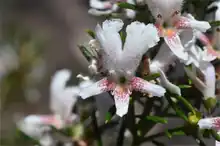| Scabrous westringia | |
|---|---|
 | |
| Scientific classification | |
| Kingdom: | Plantae |
| Clade: | Tracheophytes |
| Clade: | Angiosperms |
| Clade: | Eudicots |
| Clade: | Asterids |
| Order: | Lamiales |
| Family: | Lamiaceae |
| Genus: | Westringia |
| Species: | W. angustifolia |
| Binomial name | |
| Westringia angustifolia | |
 | |
| Known range of Westringia angustifolia (in blue) | |
| Synonyms | |
| |
Westringia angustifolia, commonly known as scabrous westringia,[2] is a flowering plant in the family Lamiaceae and is endemic to Tasmania. It is a small, upright shrub with mauve or white flowers.
Description
Westringia angustifolia is a small shrub, 1–3 m (3 ft 3 in – 9 ft 10 in) high with rigid, spreading branches. The leaves are arranged mostly in whorls of three, about 1.5–3.5 mm (0.059–0.138 in) long, on upright, slender stems about 1–2 mm (0.039–0.079 in) long, slightly bent backwards and a sharp tip at the apex. The lower surface has soft, silky hairs, the upper surface sometimes covered in small, coarse hairs. The flowers are borne in leaf axils on a pedicel, they may be white to pale lilac, with yellow, crimson or purple dots on the lower petals of the throat. Flowering occurs from October to December and most likely pollinated by insects, the fruit is a nutlet with furrowed veins on the surface.[2]
Taxonomy and naming
Westringia angustifolia was first formally described in 1810 by Robert Brown and the description was published in Prodromus Florae Novae Hollandiae et Insulae Van Diemen.[3] The specific epithet (angustifolia) means "narrow leaved".[4]
Distribution and habitat
Scabrous westringia is an uncommon species in Tasmania, it is found mainly in dry, shrubby understorey and rocky hillsides often associated with riverbanks, on dolerite soils, at altitudes of 300–900 m.[2][5]
References
- ↑ "Westringia angustifolia". Australian Census. Retrieved 23 September 2021.
- 1 2 3 "Westringia angustifolia" (PDF). Threatened Flora of Tasmania. Dept of Primary Industries, Water and Environment, Tasmania. 2021. Retrieved 19 September 2021.
- ↑ Brown, Robert (1810). Prodromus florae Novae Hollandiae et insulae Van-Diemen, exhibens characteres plantarum quas annis 1802-1805 (1 ed.). London. p. 501.
- ↑ Sharr, Francis Aubi; George, Alex (2019). Western Australian Plant Names and Their Meanings (3rd ed.). Kardinya, WA: Four Gables Press. p. 133. ISBN 9780958034180.
- ↑ Jordan, Greg. "Westringia anguvstifolia". Key to Tasmanian Vascular Plants. University of Tasmania. Retrieved 23 September 2021.